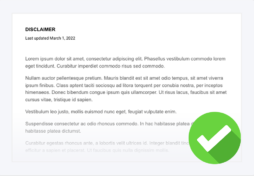If you receive product endorsements on your website, you need an affiliate disclosure as required by groups like the U.S. Federal Trade Commission (FTC).
An affiliate disclosure informs website visitors that companies compensate you for mentioning their products in your content.
Read on to learn more about what an affiliate disclosure is, the legal requirements, and how to write one for your website.
Generate a Free Affiliate Disclaimer With Termly
Here’s how you can use Termly’s generator to create a custom and legally compliant disclaimer with an affiliates section.
Step 1: Go to Termly’s disclaimer generator.
Step 2: Answer a few simple prompts and questions, and go through all the steps until you reach “Final Details.”
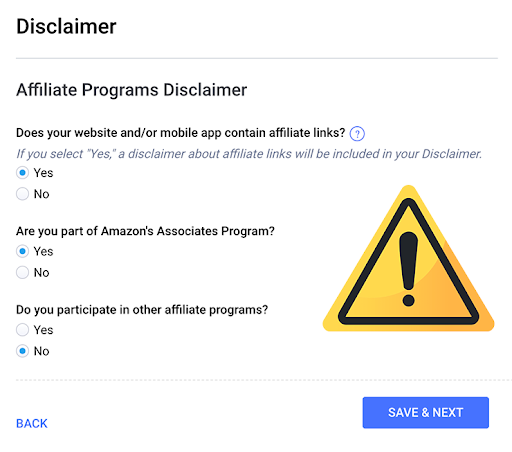
Step 3: Once you’ve filled in everything and you are satisfied with the preview, click “Publish.”
You will then be prompted to create an account on Termly so you can save and edit your legal disclaimer further.
How To Write an Affiliate Link Disclosure
If you decide to write your own affiliate disclosure, follow these easy steps.
Step One: Identify All Sponsored Content
First, identify all affiliate links or sponsored content on your website and explain that you get compensation from the companies whose products or services you link to.
Your disclosure should appear on every page of your website that features sponsored or affiliate materials.
Step Two: Use Clear and Simple Language
Next, ensure you’re using plain language when letting users know that you receive compensation from companies when you feature or link to their products in your content.
Avoid being overly lengthy or wordy, and don’t use any legalese or unnecessary jargon.
If you use terms that readers may not be familiar with — like affiliate marketing or affiliate links — explain them by including their definitions.
Step Three: Make Your Disclosure Prominent
Your affiliate disclosure must be easy for users to find and read, so make sure you title it appropriately and prominently display it.
Format it in a way that users will easily notice, for example:
- Use large enough text size
- Ensure the font is easy to read
- Use a font color that stands out
Step Four: Avoid Distracting Elements
Don’t use any distracting elements that reduce the noticeability or readability of your affiliate disclosure, such as:
- Graphics
- Buttons
- Links
In the U.S., this is required as part of the FTC requirements for affiliates and influencers.
Step Five: Post Your Affiliate Disclosure In Multiple Places
To ensure that site visitors notice your affiliate disclosures, display them multiple times or in various locations.
For example, disclosures can be placed:
- In the website footer
- In the sidebar of your site
- Fixed in place so readers see it while scrolling
If your site often features affiliate links, post an affiliate disclaimer on every page.
What Is an Affiliate Disclosure?
An affiliate disclosure or disclaimer is a statement on your website informing users that companies compensate you for promoting, reviewing, or recommending their products or services.
It alerts users of the presence of affiliate links on your site, which are URLs that link to another business’s products or services.
Site owners typically earn commissions when users make purchases through these links.
Affiliate link disclosures are required by groups like the FTC in the U.S., but it’s also a business best practice to post them.
Product reviews or recommendations can influence users’ purchasing decisions, so an affiliate disclosure establishes transparency and trust with your users, allowing them to make more informed decisions.
Affiliate Marketing Disclaimer Requirements
In the U.S., you must have an affiliate disclosure if you’re financially or otherwise compensated by companies to review their products on your site as part of the FTC endorsement guide.
An FTC-compliant affiliate disclosure should “clearly and conspicuously” describe the nature of your relationship with the company you’re posting about, including that they compensate you.
You must write your affiliate blog disclaimer using user-friendly language so it’s easy for all readers to understand.
In addition to the FTC, affiliate programs you participate in may require you to have an affiliate disclosure.
For example, the Amazon Associates Program’s Operating Agreement requires Amazon Associates to include an Amazon affiliate disclosure on their site, as shown in the screenshot.

To operate your business website ethically and avoid legal action, you must abide by the FTC guidelines and any applicable affiliate program rules.
Where To Put Affiliate Disclosures
Per FTC guidelines, affiliate disclosures should be displayed conspicuously and as close to your affiliate links or endorsed product mentions as possible.
Place an affiliate disclosure on every page that includes a sponsorship, affiliate link, or endorsement.
Your affiliate link disclosure should always come before any affiliate links so users know about your affiliate partnerships before clicking on one.
Some examples of places where you should link your affiliate disclosure page include:
- Site header
- Footer
- Sidebar
- Terms and conditions agreement
- Privacy policy
Make An Affiliate Disclosure Page
Although affiliate disclosures should appear on every page that includes affiliate links and content, you may also choose to expand upon your relationship with sponsors and affiliates with a dedicated affiliate disclosure page.
Just remember to also disclose your relationship with affiliates on your disclaimer page.
Include a hyperlink to your affiliate disclosure page throughout your site, and include smaller affiliate disclosures close to any affiliate links that appear in your content.
Affiliate Disclosure Examples
Let’s review some affiliate disclosure examples to see how they’re incorporated into websites.
Statrys
Statry’s blog about finance contains information about its affiliate programs and affiliate links.
The disclosure informs readers that Statrys may receive a small commission at no additional cost to readers. They further explained that the affiliate partners and links are from products and services they trust, and their purpose is to help support more valuable content creation, as shown in the screenshot below.

Statrys only adds a disclaimer at the bottom of articles that contain affiliate links.
Cookie and Kate
Cooking blog Cookie and Kate’s affiliate discretion page features information about their affiliate links and sponsored relationships and
It clearly explains how commissions are earned through affiliate links and lists the affiliate programs the site owner participates in, as shown in the screenshot below.
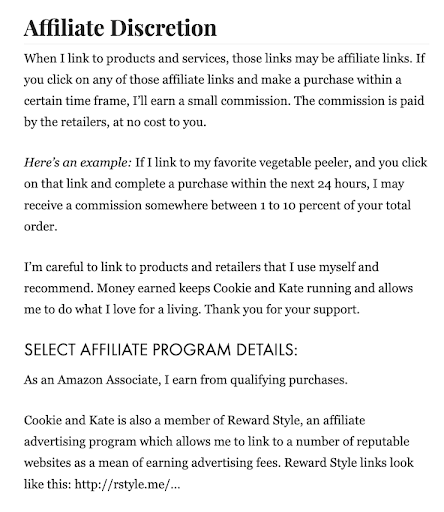
Additionally, an affiliate disclosure statement appears before the actual affiliate links within the site’s actual content and in the website footer, as shown in the following screenshot.
Follow Cookie and Kate’s example and link to an affiliate disclosure page to provide a more detailed description of your affiliate relationships and page-by-page affiliate disclosures.
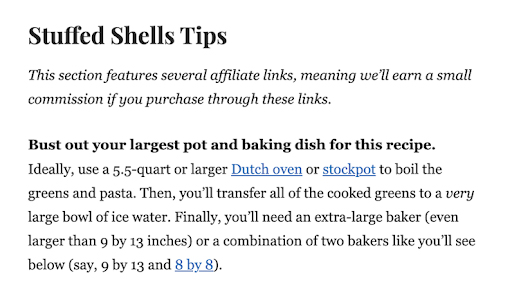
Keep your language simple, and provide a clear explanation of how you’re compensated through affiliate links.
The Beauty Look Book
Cosmetics review blog The Beauty Look Book’s disclosure page includes an affiliate disclosure section describing the sponsored partnerships and affiliate arrangements the site owner is involved in.
It also goes over the purpose of affiliate links and addresses how the honesty and quality of content are maintained, as shown in the screenshot below.
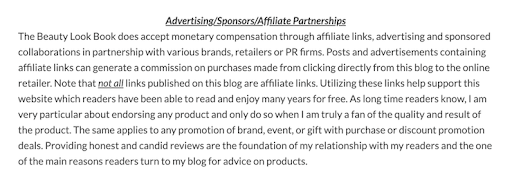
Be just as transparent about your business partnerships with other companies and explain the purpose of affiliate links so readers know you value honesty and want them to make informed judgments about your content.
The blog also features a fixed affiliate disclosure in the sidebar that shows up in every post, as shown below.
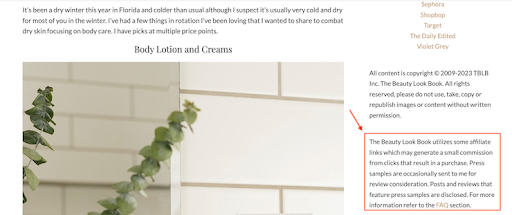
Adding a fixed affiliate disclosure in the sidebar is an excellent way to ensure noticeability and better compliance with the FTC.
Where in the World is Nina
Travel blog Where in the World is Nina includes an Amazon affiliate disclosure statement at the top and bottom of every post.
The disclosure statement links to Where in the World is Nina’s privacy policy, where the Amazon affiliates’ disclosure shows up again.
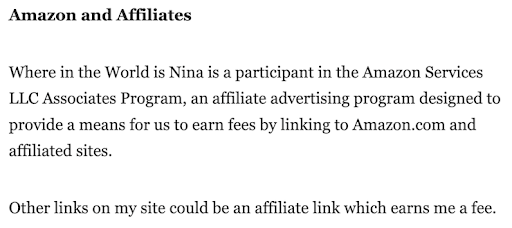
If you participate in the Amazon Associates Program, you must include an affiliate disclosure that identifies you as an Associate, as this example does.
Summary
Whether you write your own affiliate link disclaimer or use a generator to make your affiliate disclosure, make sure you meet all FTC requirements when posting these important disclaimers to your website.
An affiliate disclosure is both a legal requirement and a best business practice, so remember:
- An affiliate disclosure is a statement that specifies that you get compensated by companies whose products or services you mention or link to on your site.
- In the U.S., the FTC requires websites with endorsements to include affiliate disclosures.
- Some affiliate marketing programs also require affiliate disclosure statements.
- An affiliate disclosure should be written and displayed clearly and conspicuously.
If your site features endorsements or affiliate links, add an affiliate disclosure so your users can make informed decisions about your content.
Once your policy is created, link it throughout your site in addition to your affiliate disclosure statements on all pages where affiliate links or products appear.
You can easily make one for your site using Termly’s free disclaimer generator and indicate your use of affiliate deals directly in the builder.


